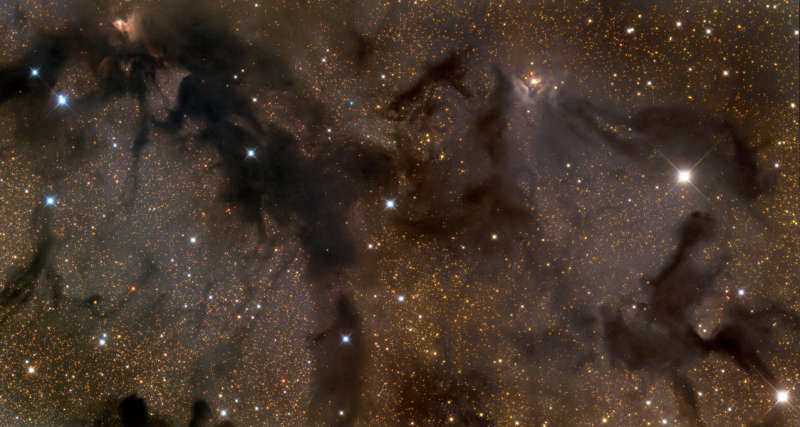Explanation: Part of a dark expanse that splits the crowded plane of our Milky Way galaxy, the Aquila Rift arcs through the northern hemisphere's summer skies near bright star Altair and the Summer Triangle In silhouette against the Milky Way's faint starlight, its dusty molecular clouds likely contain raw material to form hundreds of thousands of stars and astronomers eagerly search the clouds for telltale signs of star birth. This telescopic close-up looks toward the region at a fragmented Aquila dark cloud complex identified as LDN 673, stretching across a field of view slightly wider than the full moon. In the scene, visible indications of energetic outflows associated with young stars include the small red tinted nebulosity RNO 109 at top left and Herbig-Haro object HH32 above and right of center. The dark clouds in Aquila are estimated to be some 600 light-years away. At that distance, this field of view spans about 7 light-years.
1999 2000 2001 2002 2003 2004 2005 2006 2007 2008 2009 2010 2011 2012 2013 2014 2015 2016 2017 2018 2019 2020 2021 2022 2023 2024 2025 |
Yanvar' Fevral' Mart Aprel' Mai Iyun' Iyul' Avgust Sentyabr' Oktyabr' Noyabr' Dekabr' |
NASA Web Site Statements, Warnings, and Disclaimers
NASA Official: Jay Norris. Specific rights apply.
A service of: LHEA at NASA / GSFC
& Michigan Tech. U.
|
Publikacii s klyuchevymi slovami:
dark nebula - Molekulyarnye oblaka - temnaya tumannost' - zvezdoobrazovanie - pyl'
Publikacii so slovami: dark nebula - Molekulyarnye oblaka - temnaya tumannost' - zvezdoobrazovanie - pyl' | |
Sm. takzhe:
Vse publikacii na tu zhe temu >> | |
